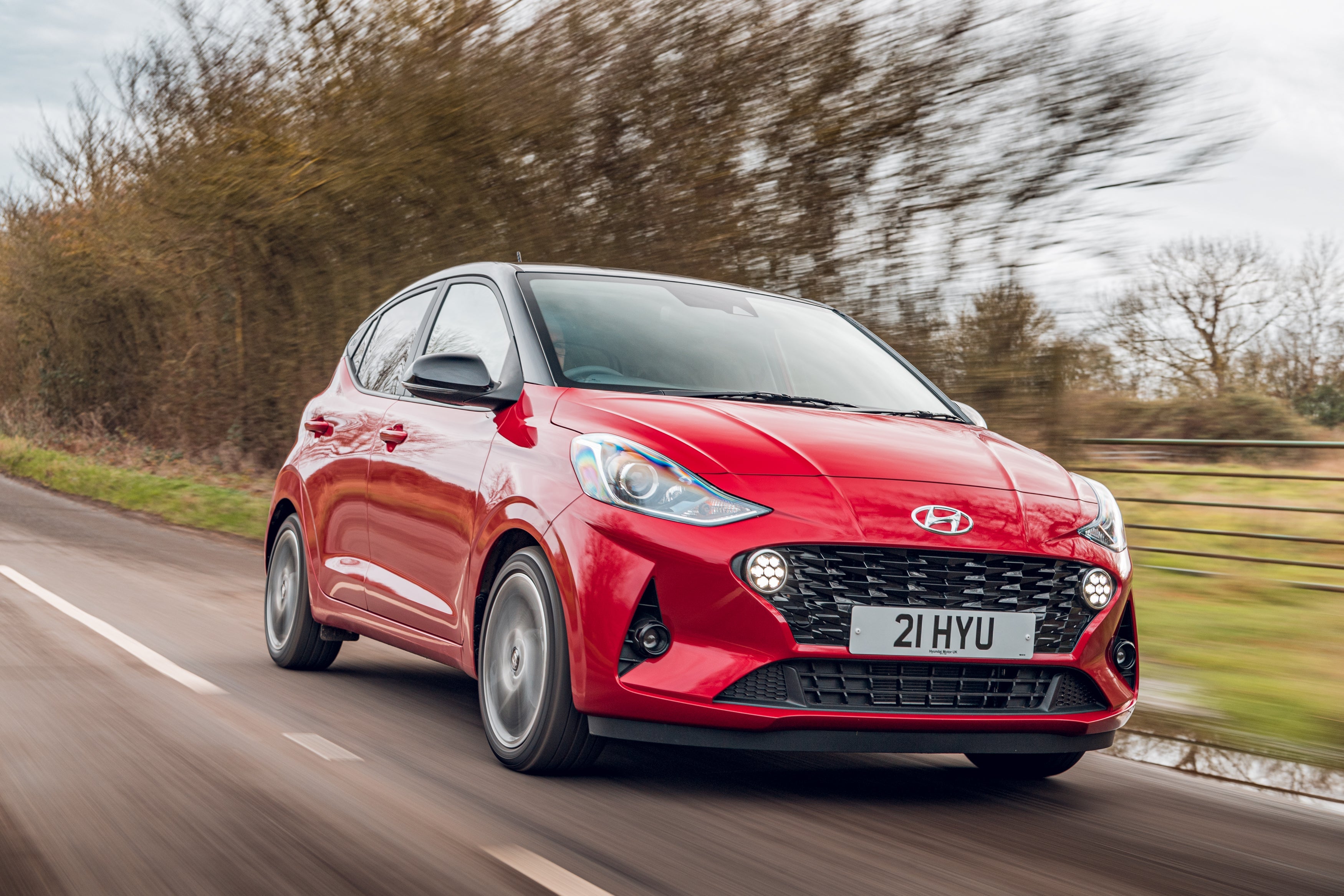Hyundai i10 Review 2025: Price, specs & boot space
Written by David Ross
Quick overview
Pros
- Ideal city car that offers more space for the money than many rivals
- Comes with comprehensive five-year warranty
- Very comfortable thanks to excellent ride quality
Cons
- Sluggish automatic gearbox is best avoided
- No adjustable boot floor
- 1.0-litre engine is a little strained at motorway speeds
Verdict: Is the Hyundai i10 a good car?
“The Hyundai i10 is pretty much the perfect city car. It offers more space than most, is incredibly comfortable yet remains good value for money. It's one of the best city cars you can choose.”
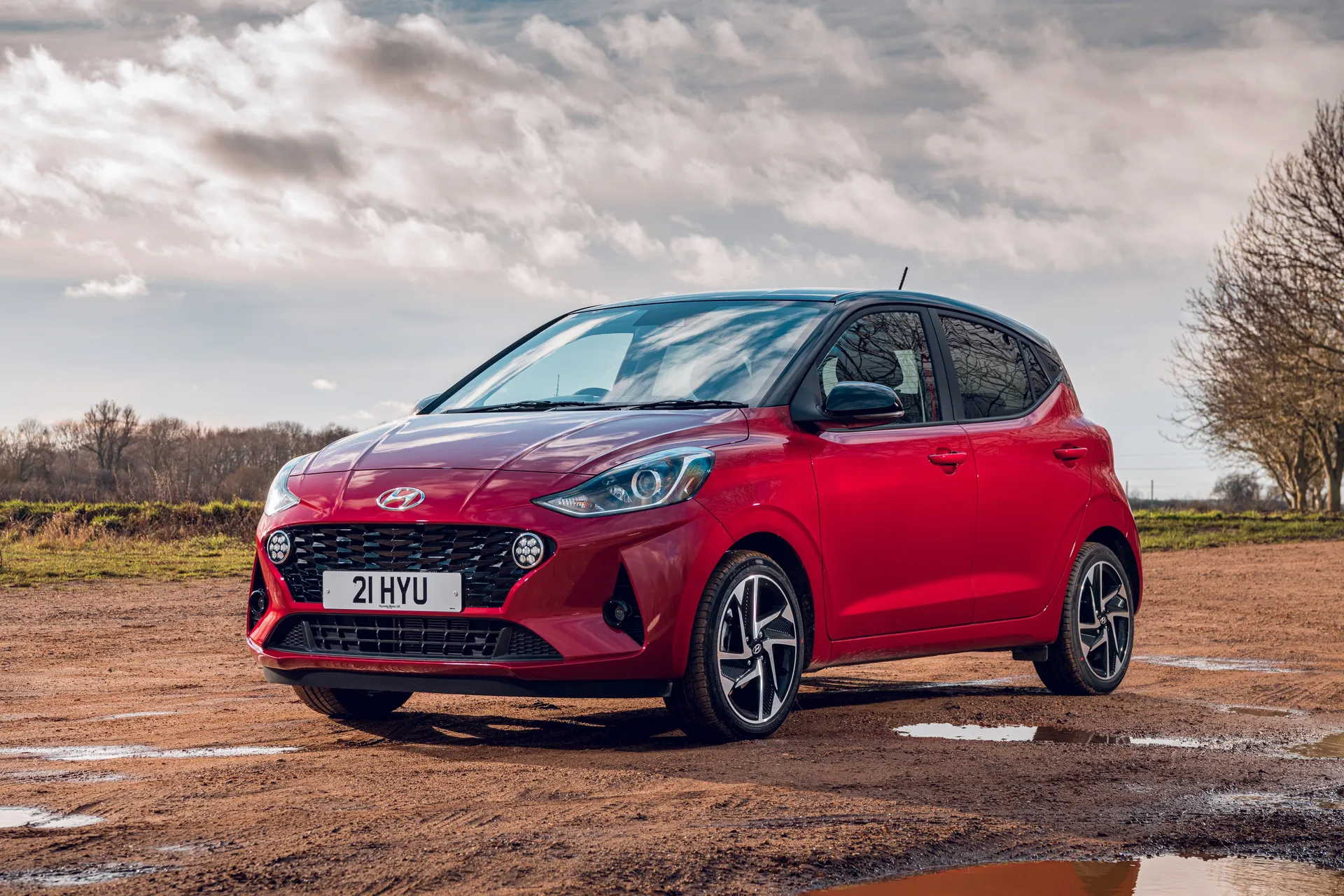
When it comes to good quality city cars, buyers are spoilt for choice, so it takes something special to stand out. As you'll read in our Hyundai i10 review, this is one of the best city cars on sale, and not merely because it’s such good value.
Put the price to one side for a moment: the Hyundai i10 is simply a great little car in its own right. And when we say ‘little’ we don’t mean that in a bad way as this is a car that is easy to stick in a small space or whizz around a multi-storey car park in. Yet, according to Hyundai at least, it can carry five adults, albeit with a squeeze.
The Hyundai i10 is a little unusual in terms of size as it straddles the gap between a city car like the Toyota Aygo and a small hatch (think Vauxhall Corsa). It certainly feels roomier than the average city car, with good space in both the front and back.
If you’ve got young children to carry, that space will be very welcome when it comes to fitting car seats in the back. The boot is decent enough and more than sufficient for a big weekly shop, although you’ll struggle with a pushchair.
What really makes the i10 stand apart from the competition is its blend of ride and handling. The well-weighted steering and plenty of grip make it genuinely fun to drive, albeit not quite on the same level as the now-defunct Volkswagen Up, yet the excellent suspension set-up means it’s the most comfortable city car around.
It is more than capable on the motorway where it feels composed and relaxed, not something you can normally say about all city cars … especially over the noise of the engine when doing 70mph.
Of the two lower power engines, the smaller 1.0-litre MPi is actually the better choice. Despite its modest 67PS, it has a really nippy character around town thanks to the fact it’s a three-cylinder unit. The 1.2-litre is less fun although being a four-cylinder, it is more relaxed at motorway speeds. Both are cheap to run, though, and you should expect fuel economy of around 45mpg. Choose the N-Line trim and you get a 90PS turbocharged 1.0-litre that is unique to this trim.
Go for an Advance model when buying new or the mid-level SE Connect as a used option, and you’ll get pretty much all the kit you’ll need including air-con, a rear-view camera, Android Auto and Apple CarPlay plus an impressive touchscreen system. The Premium really stands out, new or used, with heated seats and even a heated steering wheel. How many other city cars come with that?
Hyundai doesn’t do ‘cheap and cheerful’ any longer, but it still stays true to its ethos of offering strong value for money. You get a lot of Hyundai i10 for the cash you pay. Put simply, if you’re in the market for a city car, the i10 is a great benchmark by which to judge everything else. We don’t think you’ll find much that can match it as an all round package.
Looking for a used car for sale? We've got 100s of Hyundai Approved Used Cars for Sale for you to choose from, including a wide range of Hyundai i10 cars for sale. If you're looking for the older version, you need our Hyundai i10 (2014-2020) review.
Is the Hyundai i10 right for you?
If you want a small car but don’t want to compromise on quality or comfort, the i10 will fit the bill perfectly for you. It may be classed as a city car but it offers more space than others like the Toyota Aygo X and in fact it can easily rival bigger stuff like a Ford Fiesta for space.
It’s also good to drive with well-weighted steering. That means it’s easy enough to park at low speed, but not so totally devoid of feel at higher speeds that it feels like you’re driving a clown car. But its best feature is the excellent ride quality which makes the i10 incredibly comfortable.
Hyundai as a brand is certainly on the up and the sharp design of this i10 means it’s a car we’d be proud to have sat on the driveway.
What other cars are similar to the Hyundai i10?
There’s no shortage of good city cars around with the Volkswagen Up regarded by us as the best used option (see also SEAT Mii and Skoda Citigo), although we’d argue the i10 is better value for money and offers more space. However, the Up is more fun to drive.
If it’s a long warranty you want, consider the Kia Picanto or Toyota Aygo X. After something cheaper and a little quirky? Have a look at the Suzuki Ignis, although the interior is not a match for the i10 in terms of quality.
Comfort and design: Hyundai i10 interior
“Sometimes simple is best and the interior layout of the Hyundai i10 is the perfect example of this. It has a much more appealing design than the previous Hyundai i10, yet it’s still easy to use and well laid out. ”
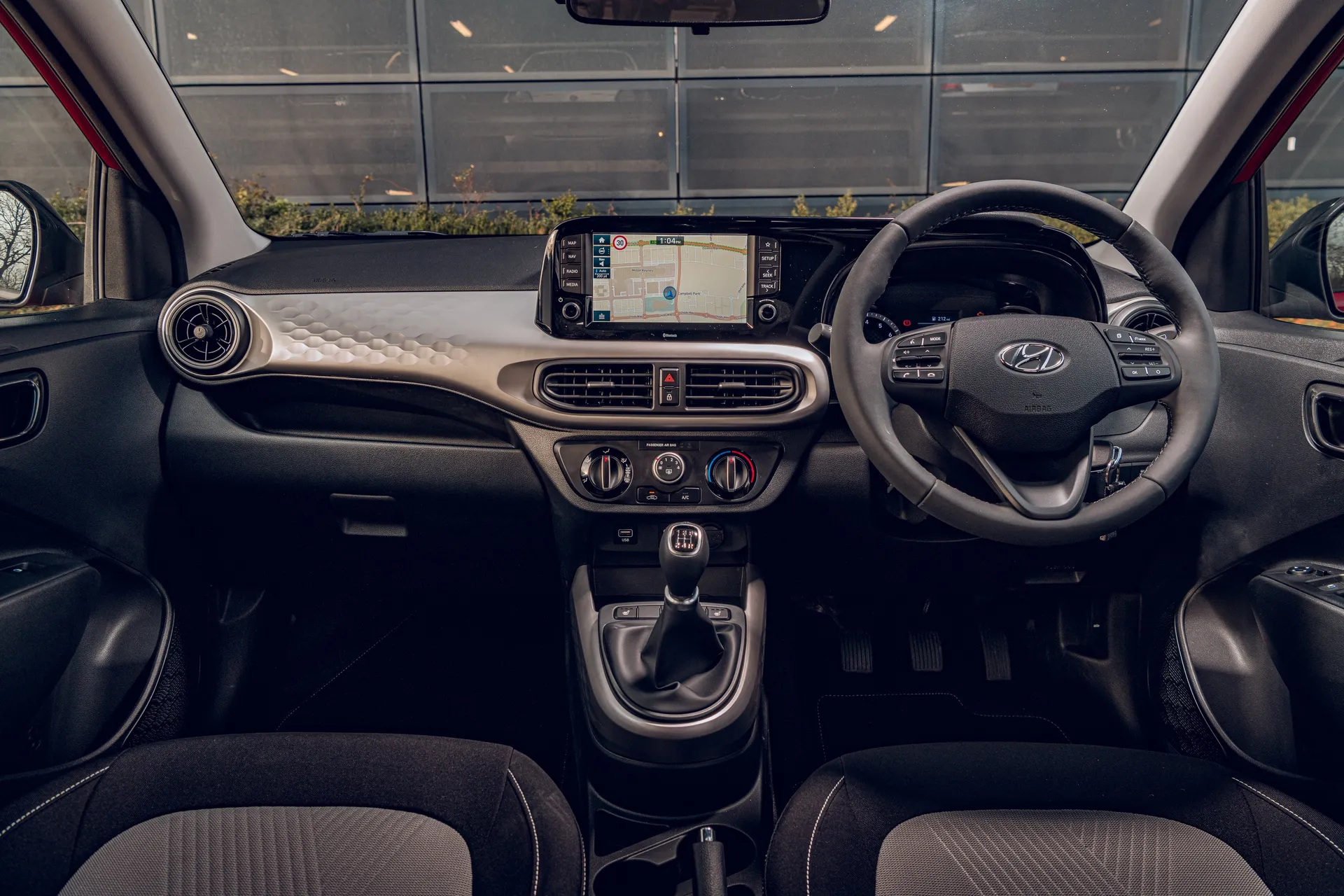
It gets the basics spot on. The driving position is excellent with the pedals, steering wheel and seat all aligned, plus the clutch isn’t too heavy and nor is the pedal too high up, an annoying quirk of some city cars. There’s even decent room for your left foot in the footwell (as long as you’re not much above a size 9).
The seats are comforting and supportive, plus all models come with a driver’s seat that can be adjusted for height, something which taller drivers will find very welcome. As with most city cars, there’s a height-adjustable steering wheel in the i10, but no reach adjustment. However, thanks to the good driving position, that’s not really an issue for most drivers.
The gear lever is raised close to your hand, while the air-con controls are nice and high and easy to use: there are no complicated touchscreen controls here, just simple rotary dials, so it’s simple to get some cold air without going for a deep dive in the menus.
True, the interior of the Hyundai i10 may not be as stylish or as design-led as some rivals - you won’t find many bright colours or funky designs here - but that shouldn’t detract from the fact that this is a very comfortable cabin.
All this means the i10 is a car that feels very comfortable and easy to drive every time you get behind the wheel. Yet even after several hours of driving, you won’t come away with back ache or cramped legs.
Quality and finish
While the Hyundai i10 doesn’t have much in the way of soft touch plastics, the materials used don’t look or feel cheap. It’s on a par with cars like the Toyota Aygo X in those stakes. In fact, we’d go as far to say that the i10 is nicer inside than most and has a more ‘big car’ feel.
If you still have any notions that Hyundai is a budget brand, think again. The i10 is really impressive inside, especially if you go for a Premium trim model, which gets nicer interior details such as a honeycomb 3D effect on the large dashboard panel, privacy glass, plus heated seats and a heated steering wheel. These are rare things to find on a city car, let alone as standard.
Adding to the quality feel of the Hyundai i10, you’ll find that doors close with a satisfying thud and all the controls work with neat precision. Features like the soft leather on the steering wheel and gear lever - standard on all models - only enhance this.
Infotainment: touchscreen, USB, nav and stereo in the Hyundai i10
With early i10s, the base-level SE comes with a DAB stereo with Bluetooth, which does the job for used buyers, although it only has two speakers and a small 3.8-inch black and white display. If you’re going to be doing more than listening to The Archers, the i10 SE Connect as a used choice or the Advance and Premium new models get a big 8.0-inch colour touchscreen with a bright and sharp display. It’s bigger than anything most you’ll find in a city car. You also get two more speakers in the back so everyone can 'enjoy' Ed Sheeran with you.
The screen is mounted high on the dashboard so it’s easy to glance at without taking your eyes off the road for too long. The system is also a doddle to use and the ‘touch’ bit is responsive, so it’s not frustrating or crash-inducing when trying to navigate menus.
Usefully, there are still buttons and controls around the display, so getting to the right menu is a doddle. We also like the standard old-school volume knob rather than anything more complicated: it makes turning up (or down) what the kids want to listen to on the school run much less stressful...
The other great feature in the i10 is Apple CarPlay and Android Auto. You can control your phone through the touchscreen and listen to podcasts, music on Spotify, books Audible and use navigation apps such as Google Maps or Waze. It’s standard on all new i10s, but not the previous SE trim.
Space and practicality: Hyundai i10 boot space
Measuring 3670mm in length, 1480mm in height and 1680mm in height, it may be classed as a city car, but the i10 feels more like the bigger Ford Fiesta in terms of passenger space. It’s very roomy, especially for elbow- and shoulder room. You’re not going to get five burly rugby players in here, but Hyundai does say you can fit five adults in, although you'll probably have to get quite cosy with one another…
The rear seats are usable, though, and that’s especially handy when it comes to fitting a car seat. It means you can have a Group 1/2/3 car seat in the back and still have just enough space for someone in the front. However, if you’ve got a rear-facing seat, it’s going to be tight for room.
The Isofix points in the back are hidden away so it’s fiddly to fit a car seat, but once in, the headrest is easy to move up out of the way. Most usefully, you can easily get the seatbelt in the buckle, something we’ve found all but impossible in cars like the larger Mazda 2.
There’s decent storage in the i10 with a handy tray for phones and wallets in front of the gear lever, plus another above the glovebox, which has plenty of room for odds and ends such as ice scrapers or those sweets you’ll forget about for several months. There are also spacious door pockets and even two cupholders, though they are a bit shallow.
The official boot capacity is 252 litres which is on a par with the Kia Picanto. The one thing you’ll notice is that the boot is very deep and not very long.
There’s no adjustable boot floor, either, but you can fit a surprising amount in the i10 easily enough with room for a three-figure supermarket shop. You will struggle with a pushchair unless it’s of a particularly compact design. The other oddity here is the parcel shelf, which doesn’t flip up with the tailgate and can get in the way. Fold the rear seats and you can free up to 1050 litres of space.
Handling and ride quality: What is the Hyundai i10 like to drive?
“Ride quality is one area where the Hyundai i10 stands head and shoulders above the competition. The suspension is balanced to deliver a comfortable and forgiving ride without being all soft and bouncy in corners.”
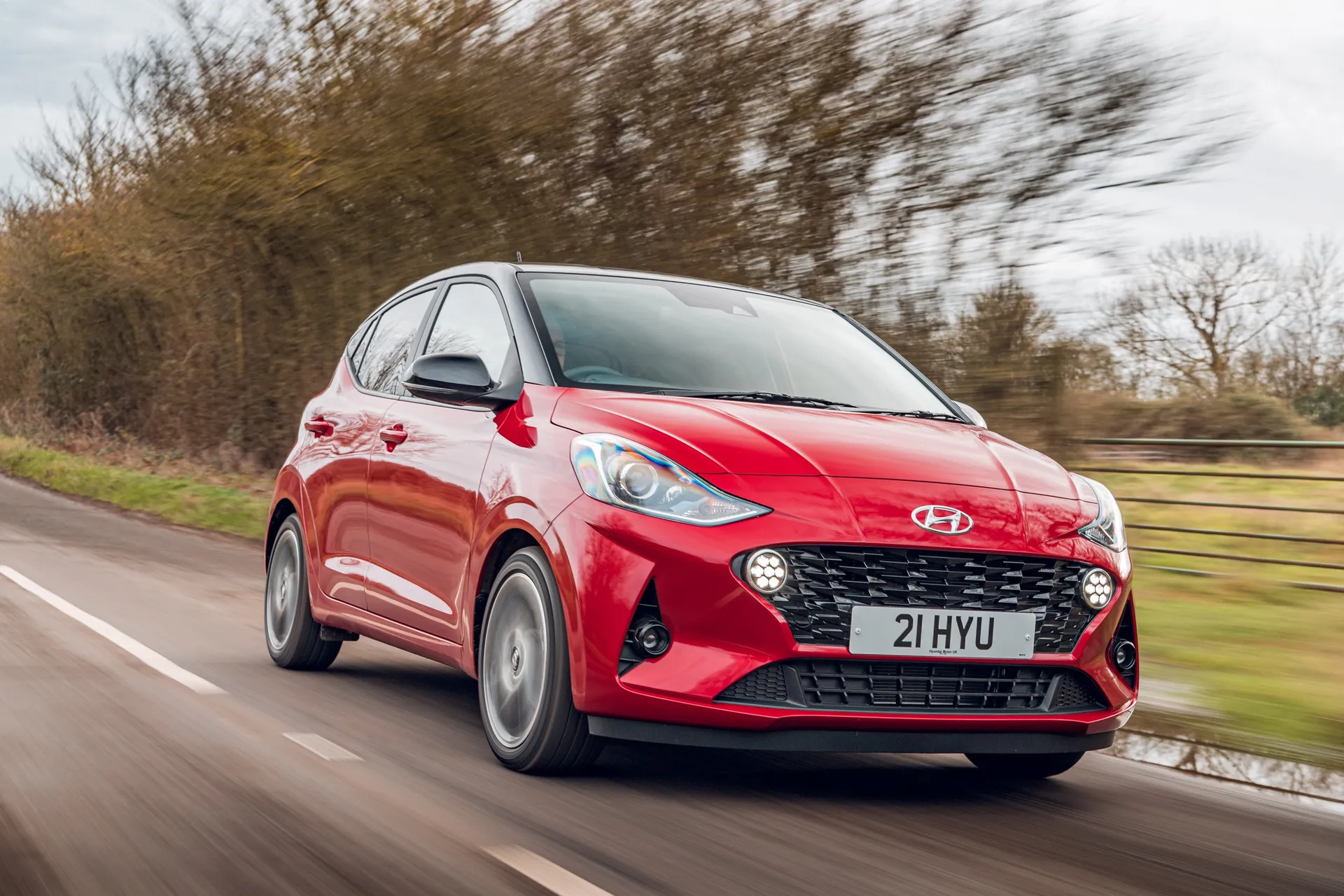
Even if you go for a model with larger 16-inch alloys, the i10 still smoothes out potholes and doesn’t fidget over rough road surfaces. That said, we’d stick with the 15-inch alloys of more modest versions if you want the edge on comfort.
Either way, very few city cars ride as comfortably. It’s not just in town that the i10 performs well, either: get it on the motorway and it impresses, being supple yet secure at speed, helped by the accurate steering.
That responsive steering comes into its own when you arrive at a corner. The little i10 is surprisingly enjoyable to drive on the twisty stuff, and while not quite as much fun as a Volkswagen Up or Mazda 2, we still think it’s entertaining.
It never becomes skittish and has plenty of front end grip, so even in the wet you know the i10 will easily handle tight turns. There’s a bit more body roll in corners than the similar Kia Picanto, but the Hyundai i10 feels like a better all-rounder with its combination of a comfortable ride and sharp handling.
Around town, the steering becomes lighter, making tight parking or getting around a packed multi-storey that was designed entirely by CAD much easier. The i10 may not be quite as small as a Fiat 500, but it’s still a doddle to slot into a tight spot. Higher spec models come with a reversing camera, too.
What engines and gearboxes are available in the Hyundai i10?
The Hyundai i10 was launched with two petrol engines. There’s no mild hybrid or similar in the line up, and no EV either, unlike rivals such as the Skoda Citigo and SEAT Mii.
The most popular engine you’ll find is the 1.0 MPi which we think is the perfect choice for the i10. Its 67PS was later changed to 63PS, and that may not be much to shout about, but thanks to the fact it’s a three-cylinder engine, it has plenty of get up and go, making it nippy away from a standstill and ideal for around town.
The one fly in the ointment here is that you may find it a little strained at motorway speeds. Not that most people will buy an i10 for its motorway prowess, but if you do intend to spend the majority of the time rocking the national speed limit, the four-cylinder 1.2-litre, which started with 84PS and now sports 79PS, is the better choice.
Both engines come with a five-speed manual gearbox as standard, which has a nice positive shift. As an alternative, there’s an automated manual transmission or AMT, which costs an extra few hundred quid.
A lot of small cars are fitted with similar gearboxes instead of a ‘proper’ automatic, mainly because they are lighter and cheaper. The problem is they are sluggish and jerky, making for a less-than-pleasant driving experience. The i10 auto is the same, so we’d stick with the manual, unless you must have an automatic.
Alternatively, you can also choose the i10 N Line version, with its unique 90PS 1.0-litre turbocharged engine, and the five-speed manual gearbox is the only choice of transmission here. It is peppier than either of its counterparts and, while not hot-hatch swift, it makes the little Hyundai plenty of fun to drive and well able to cope with motorways.
Refinement and noise levels
The Hyundai i10 feels more refined and is quieter than many other city cars. A lot more in fact. There’s better insulation from road noise than many others. As we’ve mentioned, it’s more than a match for cars in the class above, such as the Suzuki Swift. There’s not much wind noise, and even at motorway speeds, the little i10 feels like a bigger car.
The 1.0-litre MPi engine is smoother and quieter than many other three-cylinder engines, such as the one in the Aygo X. It still has a zesty and keen character that makes it fun. One thing we did notice occasionally is the engine can seem to bog down a little, so you might need to learn to give it a few more revs when pulling away.
It’s no surprise that the 1.2-litre is smoother (thanks to the extra cylinder) and so it doesn’t need to be worked as hard, for instance when joining a fast-flowing dual carriageway (rare these days) from a short slip road. The same applies to the more potent 90PS 1.0 T motor.
Safety equipment: How safe is the Hyundai i10?
City cars have come a long way in recent years and are no longer the basic A-to-B transport they once were. The i10 comes with what Hyundai labels ‘SmartSense’, which is a suite of safety features, and it certainly boasts a comprehensive list.
As standard, all Hyundai i10 models come with a host of acronyms. There’s FCAA or Forward Collision-Avoidance Assist, which uses a camera at the front to detect other cars and also pedestrians and cyclists. It will warn you if an impact is imminent and automatically brake if the driver doesn’t.
There is also Hyundai’s e-call system, which will call the emergency services if you’re unfortunate enough to be in an accident and the airbags are deployed. The i10 is fitted with high-beam assist, which automatically dips the main beams when another car is approaching or it detects streetlamps.
Of course, there is also all the standard safety equipment you’d expect such as electronic stability control (ESC), plus front-, front side- and curtain airbags. There are two Isofix child seat mounting points in the back and a mount for a top tether, although it’s not that obvious at first glance.
Despite all of this, when crash tested by Euro NCAP the Hyundai i10 scored only a very middling three-star (out of five) rating. This was due to the car's so-so performance for vulnerable road users and safety assistance systems, rather than its ability to protect those inside the car.
There’s no spare wheel in the new i10 - there’d be no room in the boot otherwise - so instead you get a tyre repair kit. Fortunately, Hyundai’s five-year warranty includes roadside assistance.
MPG and fuel costs: What does a Hyundai i10 cost to run?
“All engines are cheap to run with the official (or WLTP as it’s called these days) economy figures seeing the 1.0-litre MPi returning around 56mpg, although that depends on the trim level. In real-world driving, you should see around 50mpg.”
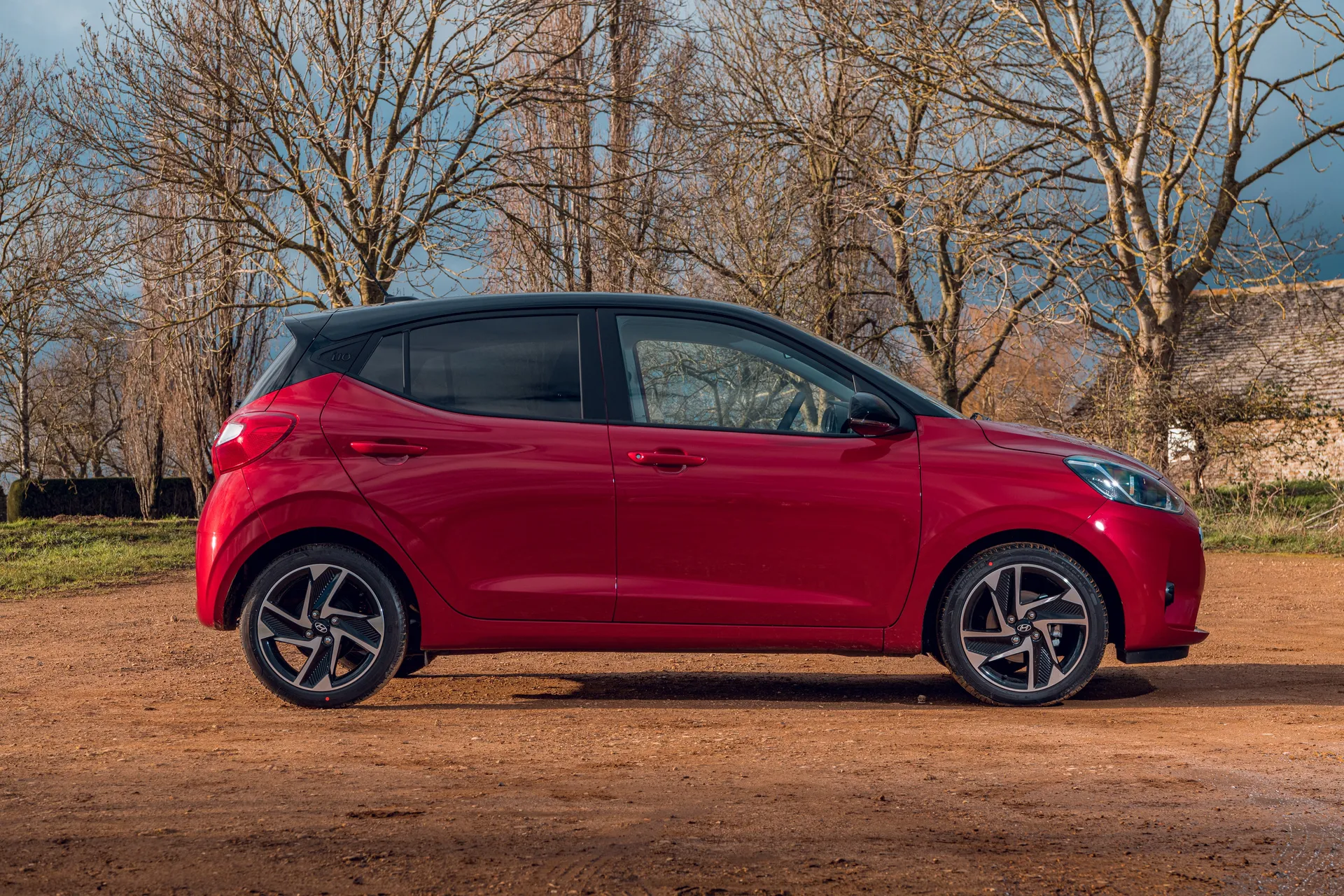
The 1.2-litre has claimed figures of around 55mpg and the real figure should be around 47mpg. Opt for the AMT gearbox and you’ll see economy drop quite a bit for both. Another reason to give it a swerve. Take the perkier 90PS 1.0 T, and it offers 52mpg according to official testing.
With a 36-litre fuel tank, you should get around 400 miles on a full tank if you go for the 1.0-litre MPi and around 370 miles in the 1.2-litre.
Hyundai i10 reliability and warranty
Hyundai performs exceedingly well in the annual HonestJohn Satisfaction Index, coming tenth for reliability (of 33 manufacturers) in the latest survey. A number of its models were also rated some of the most reliable used cars you can buy, suggesting you should have very few issues with the little i10.
Even better, Hyundai supplies a very generous warranty with its cars. The five years you get may not be as generous as what you get from Kia or Toyota, but while their warranties have mileage caps (100,000 miles), Hyundai's doesn't. If you're an uber-high-mileage driver, then it's actually the better deal, although admittedly, if you are one of those, then you probably won't be considering an i10.
Hyundai i10 insurance groups and costs
The i10 makes a great first car thanks to the fact it’s cheap to run, and that includes insurance costs, which can be particularly painful for young drivers. There are a handful of versions that enjoy a group 1 rating, but many more sit in groups 2 and 3, and none of the mainstream versions go higher than group 8.
The priciest i10 to cover is the 1.0 T N Line model, which is in a heady group 10 (out of 50 groups in the total insurance scale).
VED car tax: What is the annual road tax on a Hyundai i10?
This generation of i10 was first launched in early 2020 so you’ll pay £195 a year for your VED regardless of what model you choose. Prices for the i10 don't get anywhere near the £40,000 threshold that requires you to pay the additional 'luxury car surcharge', so you'll never have to worry about that, which is good as it can be quite painful.
Hyundai i10 price
“The i10 may not be the cheap city car it once was, but it still represents really good value."
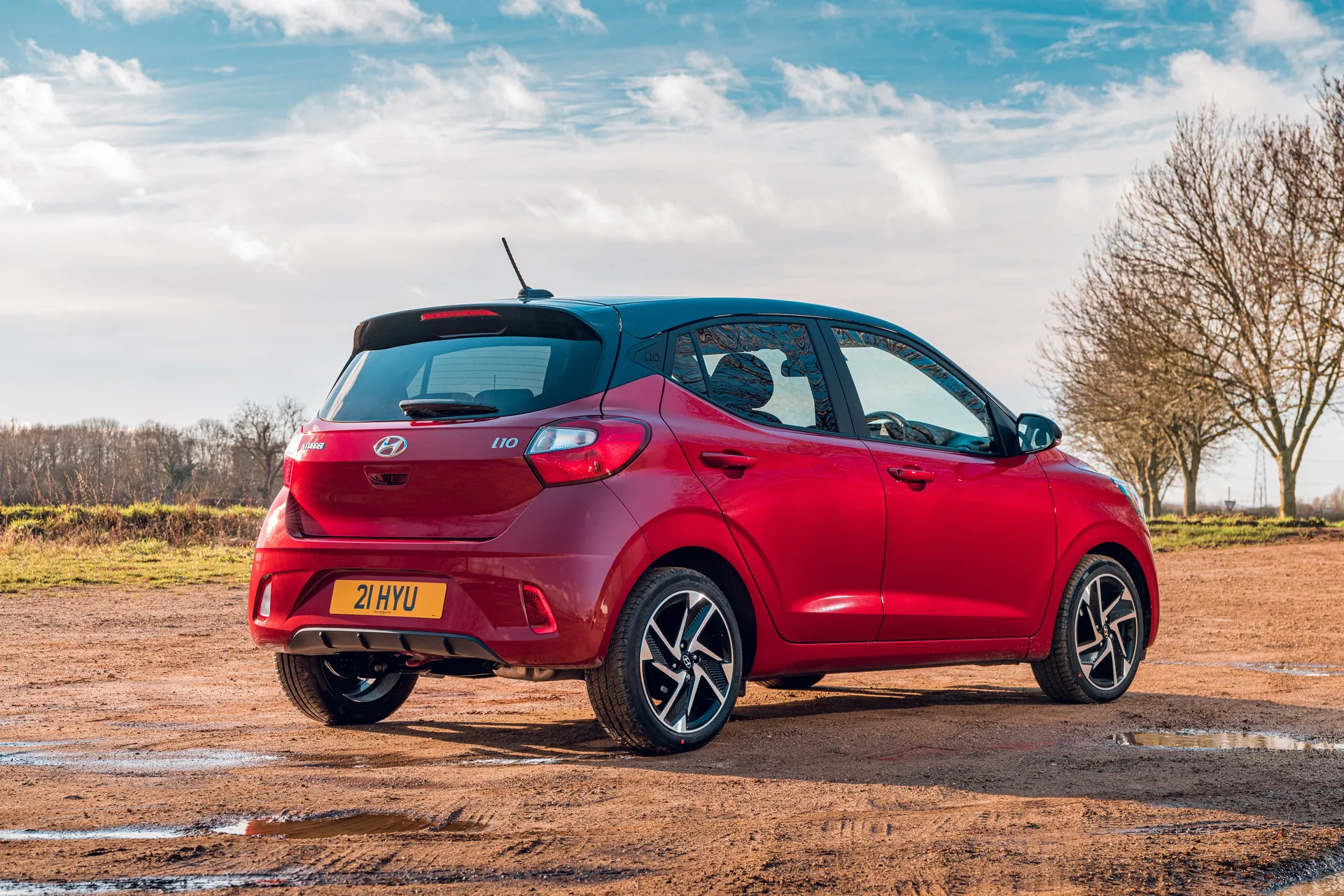
New-car prices start at around £17,000, which makes it one of the most affordable brand new cars you can buy, and as you progress up the range of engines, transmissions and trim levels, the prices don't escalate at too drastic a rate. All versions currently sit below the £20,000 barrier.
As usual, though, you can make hefty savings by turning to the used car market. Our classifieds contain lots of these third-generation cars for less than £10,000, with pretty much the full selection of engines and trim levels available at that ballpark, albeit with differing ages and mileages. Choose wisely, and you'll even find something at that money with a little bit of warranty left. Spend a couple of grand more, and you'll get a car with lots of warranty left.
Trim levels and standard equipment
When buying new, the Hyundai i10 line-up starts with the Advance trim that comes with 15-inch alloy wheels, electric windows front and back, a leather-trimmed steering wheel, and black fabric upholstery. You also get driver's seat height adjustment, air conditioning, rear-view camera, and an 8.0-inch infotainment screen with Apple CarPlay and Android Auto included.
To this, the Premium trim adds 16-inch alloys, rear disc brakes, and tartan cloth inserts for the seats. It also comes with heated front seats, heated and electrically adjusting door mirrors, keyless entry and starting, front fog lights, bi-function headlights, and rear privacy glass. One final upgrade is the wireless phone charging with the Premium version.
Then there's the standalone N Line model that has its own 16-inch wheel design, gloss black exterior trim, and N Line interior upholstery.
While the Hyundai i10 SE comes with all the basics, the SE Connect is the model to go for as a used buy, if only because it gets the proper colour touchscreen (the black and white one of the SE is very 90's…) and includes Apple CarPlay and Android Auto, plus adds two more speakers in the rear.
SE Connect replaces the basic steel wheels with proper 15-inch alloys and adds features like the rearview camera, but if you want all-singing-all-dancing, the Premium is really impressive.
It gets luxuries like heated front seats and even a heated steering wheel, something that’s rare in many high-end premium cars, let alone small city runarounds. It also adds front fog lights, LED daytime running light, rear privacy glass and 16-inch alloys. Do you need all these?
Not really, but if you thought like that, then you’d probably be driving the same car as Fred Flintstone. So if you can find a Hyundai i10 Premium model that’s not much more expensive than an SE Connect, it’s well worth it.
There aren’t many options, but the metallic paint (originally £550) is something you should expect on most used models, although the two-tone roof (originally £500) is much rarer and not worth paying extra for.
Another rarity was the additional Tech Pack, which was a hefty £1,000 option when new. This adds navigation, LIVE services, a wireless charging pad, Bluelink and Intelligent Speed Limit Warning System. Again, we wouldn’t be paying extra for this on a used car.
Ask the heycar experts: common questions
Does the Hyundai i10 make a good first car?
Is the Hyundai i10 reliable?
Has the Hyundai i10 been discontinued?
Which i10 model is the best?
Get our latest advice, news and offers
Keep me updated by email with the latest advice, news and offers from heycar.
By submitting you agree to our privacy policy
